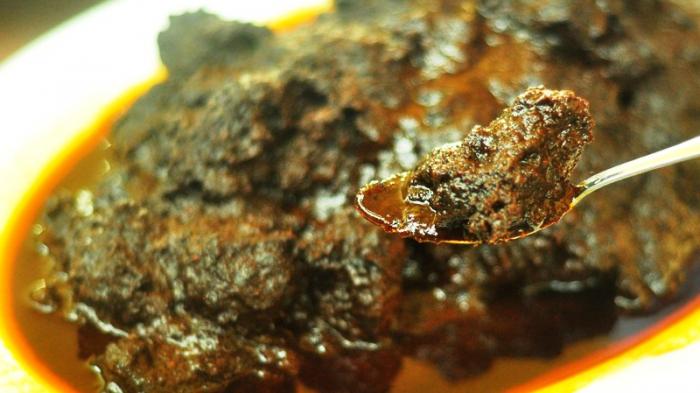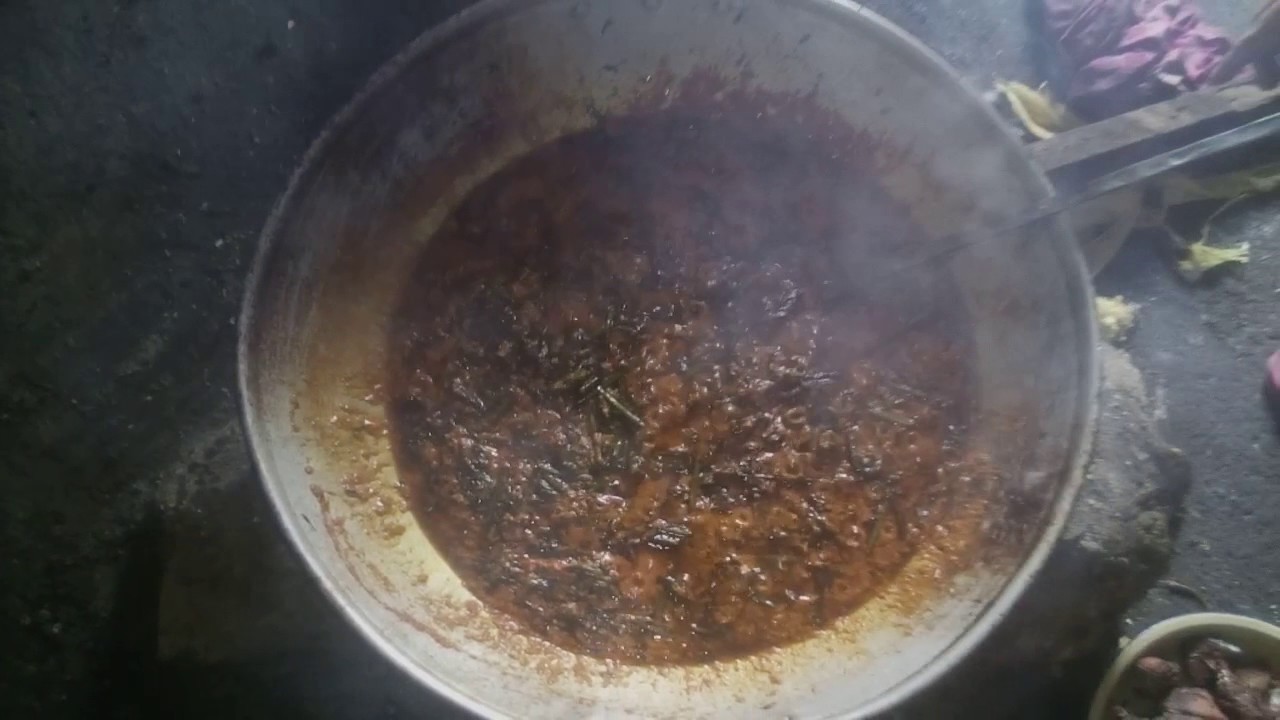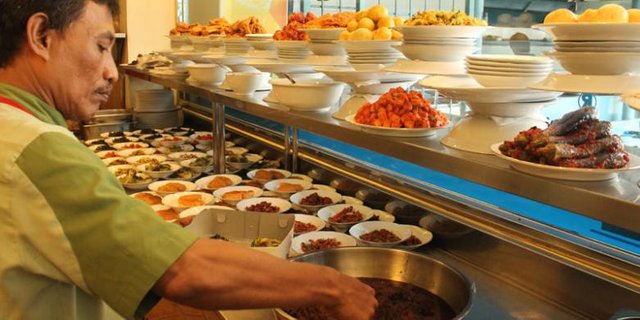Almost all people living in Indonesia know what is rendang, given the number of food stalls Padang scattered throughout the archipelago. But do any of us know about the history of this rendang cuisine? Rendang is a traditional food from the region of West Sumatra, Minangkabau precisely, made of beef covered with a spicy blend of spices.

The Origin of Rendang Cuisine
Where do rendang's origins come from? Notes on rendang as Minang traditional culinary began to be written massively in the early 19th century.
Rendang or Randang is a spicy flavored meat dish that uses a mixture of various herbs and spices. This cuisine is produced from a heated cooking process repeatedly with coconut milk. The cooking process takes hours (usually about four hours) to dry and solid black. At room temperature, rendang can last for weeks. Rendang is cooked in a shorter time and the coconut milk has not dried up called kalio, a light brown golden color.
Rendang can be found in Padang Restaurant around the world. This cuisine is popular among the people of Indonesia and countries in Southeast Asia, such as Malaysia, Singapore, Brunei, Philippines, and Thailand. In its home area, Minangkabau, rendang is served in various traditional ceremonies and special occasions. Although rendang is a traditional Minangkabau cuisine in general, each area in Minangkabau has different cooking techniques and use of spices.

In 2011, rendang was crowned as the first ranked dish in the World's 50 Most Delicious Foods list (50 World's Best Cuisine) held by CNN International.
Rendang is a dish that contains rich herbs. In addition to the basic ingredients of meat, rendang using coconut milk (karambia), and a mixture of a variety of distinctive spices are mashed, including pepper (lado), lemongrass, galangal, turmeric, ginger, garlic, onion and various other spices are usually referred to as cookers .
The uniqueness of rendang is the use of natural herbs, which are antiseptic and killing pathogenic bacteria so as to be a natural preservative. Garlic, onion, ginger, and galangal are known to have strong antimicrobial activity. Not surprisingly, rendang can be kept one week to four weeks.
The original rendang cooking process can take hours (usually about four hours), which is why rendang cooking takes time and patience. Pieces of meat cooked with herbs and coconut milk in the proper heat of heat, stirred slowly until coconut milk and seasoning absorbed the meat. After boiling, the fire is reduced and stirred until coconut thickens and becomes dry.
Cooking rendang should be patient and painstakingly waited, always carefully turned back and forth to keep the coconut milk dry and the seasoning perfectly absorbed, without burning or destroying the meat. This cooking process is known in modern culinary arts with the term 'caramelization'. Because using many types of spices, rendang is known to have a complex and unique flavors.
In cooking spiced meat in coconut milk, when viewed from the liquid content of coconut milk, there are actually three levels of stages, ranging from the wettest berkuah to the driest: Gulai - Kalio - Rendang. From this sense the true rendang is the lowest rendang of the liquid content. However, there are generally two types of rendang: dry and wet rendang.
Well, because the rendang is drier, then he is more durable compared to the curry. Until now, many who like to bring it as souvenirs or provision of long trips, such as pilgrimage or abroad.
The Meaning of Culture Rendang
Rendang has an honorable position in Minangkabau culture. Rendang has its own philosophy for the people of West Sumatera Minang, the deliberation and consensus, which departs from the four basic materials that symbolize the integrity of Minang society, namely:
Dagiang (beef), is a symbol of "Niniak Mamak" (tribal leaders)
Karambia (coconut), is the symbol of "Cadiak Pandai" (Intellectuals)
Lado (chili), is a symbol of "Alim Ulama" is spicy, firmly to teach the religious shari'a
The cooker (seasoning), is the symbol of the whole Minangkabau community.
In Minangkabau tradition, rendang is a dish that must be served in every special occasion, such as various Minangkabau traditional ceremonies, kenduri, or welcoming guests of honor.
In Malay tradition, whether in Riau, Jambi, Medan or Malay Peninsula, rendang is a special dish served in circumcision circumcision, birthday, wedding, barzanji or religious event, such as Idul Fitri and Idul Qurban.
A search about the history of rendang will take us to one of the areas in western Sumatra, namely Minangkabau. For Minang people, rendang has been one of their culinary life since the time of their ancestors. For the history of the first time rendang was created by itself, unfortunately there is not much written evidence to be found. One of the allegations that emerged among researchers is that this snack has emerged since the Minang people held their traditional event for the first time. Beginning of the history of typical rendang Padang cuisine is heard everywhere may occur because the art of cooking continues to grow from Riau, Mandailing, Jambi, even to Negeri Sembilan which is a federation state of Malaysia because Minang migrants who live there.

Notes on rendang as a traditional food from the Minangkabau region were discovered in the early 19th century, but Gusti Anan, a historian from the University of Andalas in Padang has the notion that rendang has started to emerge since the 16th century. This he concludes from the 19th century literary record where it is written that the Minang land people often travel to the Malacca Strait to Singapore. They travel through the waterway and can take about a month. Given the absence of a township along the way, these immigrants must have prepared a meal that will last for a long time, and the food is rendang. Gusti also suspected that the opening of new villages on the east coast of Sumatra to Singapore, Malacca, and Malaysia by the Minang community in the 16th century had also included rendang as their food because the journey took months.
Apart from the historical record, the history of typical Padang rendang cuisine can also be found in Colonel Stuers's diary, which in 1827 wrote about culinary and literature. In the note often appears implicitly culinary descriptions that allegedly lead to rendang and written terms of blackened and scorched food. This, according to Gusti, is one of the preservation methods commonly done by Minang people. Rendang itself comes from the word "bears," which is to cook the coconut milk until dry slowly this is suitable with rendang which takes a long time to cook until the broth is dry.
History of rendang is also not separated with the arrival of people from Arabia and India in the west coast of Sumatra. It is believed that in the 14th century, there were already many Indians living in the Minang area, and spices and herbs had been introduced by these people. There are also allegations that the curry dishes that have become typical Indian food and introduced in the 15th century in the Minang area is the basis of rendang itself. This is quite possible given the trade contract with India at that time. The heirs of the Paguruyung throne also reveal the possibility that rendang is a further processed curry. What makes it different is the rendang has a drier nature, so it can be much more durable when compared to the curry.
Padang typical rendang cuisine remains not dead until now, even becoming more famous with the proliferation of food stalls in every corner of the city Padang in the archipelago. Although known by its form made of meat, it turns out there are many other variations of rendang such as chicken rendang, duck, liver, egg, lung, and tuna. In addition there are also rendang suir coming from Payakumbuh. What distinguishes rendang suir with the usual rendang is chicken or beef meat used, the fiber will be fried in small pieces.
Philosophy Behind Rendang

Padang traditional rendang food as a traditional dish has a respectable position in community life in Minangkabau. This is because the ingredients of rendang makers have their own meaning. The first ingredient is dagiang or beef which is also the main ingredient symbolize niniak mamak and bundo kanduang, where they will give prosperity to child of banana and child of niece. The second ingredient is karambia or coconut, which symbolizes the intellectuals or those in Minang language called Cadiak Pandai, in which they bring together the group and the individual. The third is Lado or sambal as a symbol of pious and pious scholars in teaching religion. The last ingredient is the cooker or seasoning, which symbolizes each individual in which each individual has his or her own role to promote group life and is the most important element in the life of the Minang society.
if you like this post don't forget to upvote :D for me I would really appreciate your upvote